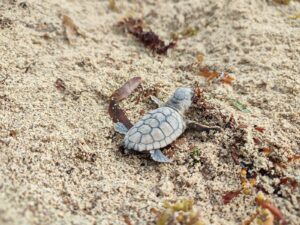Sandy Turtle: A Site for the Conservation of Sea Turtles in the Mexican Caribbean

Sandy Turtle, or El Campamento, is a beautiful refuge between mangroves, jungle and beach just thirty meters from the ocean. Its circular design is a testament to the refuge’s mission: to reduce plastic waste, promote a more nature-friendly way of life, and raise awareness of issues and threats in marine and coastal ecosystems.
Part of Sandy Turtle’s functions is to be a strategic site for the monitoring of two species of sea turtles that nest on the southern coast of Quintana Roo: the green turtle and the loggerhead turtle. However, turtle nesting and egg hatching are becoming an almost impossible daily battle for sea turtles, as threats such as sargassum landings, beach erosion and plastic pollution are increasing with each nesting season and are therefore hindered in their attempt to lay eggs and if success allows, The hatchlings that emerge are disoriented by plastic and sargassum, and are most often preyed upon before they reach freedom in the sea, just twenty meters away.
Therefore, the Sandy Turtle project aims to help sea turtles nest, hatch and find their way to the sea safely, by conducting weekly and monthly beach clean-ups, collecting data on plastic quantities, and full-time monitoring of sea turtles by biologists. But this is not enough. The long-term solution is to reduce plastic waste and stop the dumping of nutrient-rich fertilizers into our oceans. Only then will Mahahual’s sea turtles thrive as they once did.
Cleaning
We are the first plastic cleanup operation in Mexico to use data! Why? Because we would like to understand, and show, the depth and scope of the problem. Our working method involves timed cleanings in a given beach area, where we go in search of PEDs, HDPE, glass, shoes, flip-flops, ropes, synthetic fibers and waste in general, then the waste is weighed, cleaned, separated and stored in our facilities. The reusable is shredded into pellets and smaller pieces, and eventually become part of art, crafts, and longer-lasting products.
‘Nurdles’
After each cleanse, we have to go in search of “Nurdles”. They are difficult to detect, but it is a necessary job and a responsibility that we have to carry after producing them. These are tiny microplastic pellets that form the basis of other plastic objects. Due to spills, monitoring, and manufacturing plants, they have begun to appear in our waterways, rivers, and oceans. They’re so small that they’re virtually impossible to remove from our oceans, so we’re trying to collect as much data as possible on them. Even worse, nurdles have been shown to absorb toxic chemicals inside them as they travel through the ocean and make excellent transport vessels for all kinds of bacteria.

The form does not have Goals enabled.
- LAST DAY : never, all donations are always open! Donate Now
RECENT CAUSES
-
Art & Environmental Education
Many plastics that wash up on our beach are non recyclable. For this reason, the initiative to create art with fishing nets and flip-flops, mainly, arises. However, creativity has no limits. Sometimes volunteers let their imagination run wild to create something tangible and visual with the plastic waste that arrives through the ocean currents.
-
Nurdles
They are difficult to detect, but it is a necessary job and a responsibility that we have to carry after producing them. These are tiny microplastic pellets that form the basis of other plastic objects. Due to spills, monitoring, and manufacturing plants, they have begun to appear in our waterways, rivers, and oceans.
-
Cleaning
We are the first plastic cleanup operation in Mexico to use data! Why? Because we would like to understand, and show, the depth and scope of the problem. Our working method involves timed cleanings in a given beach area, where we go in search of PET (plastic bottles), HDPE (dense plastics), glass, shoes, flip-flops, ropes, synthetic fibers and waste in general, then the waste is weighed, cleaned, separated and stored in our facilities.

